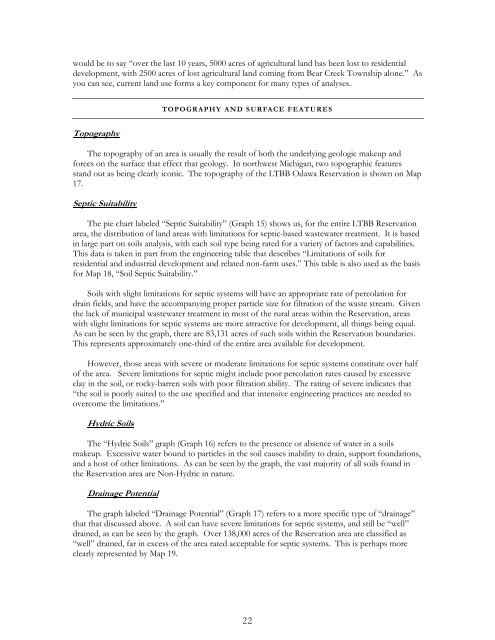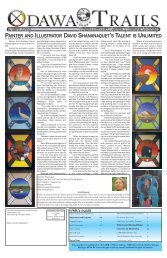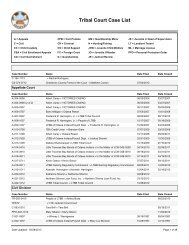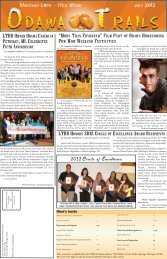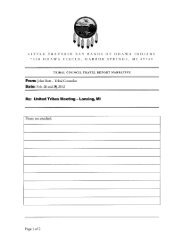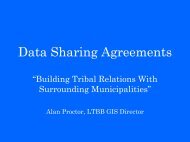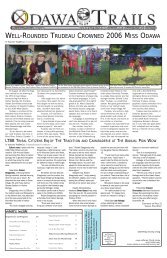LTBB Master Land Use Plan - Little Traverse Bay Bands of Odawa ...
LTBB Master Land Use Plan - Little Traverse Bay Bands of Odawa ...
LTBB Master Land Use Plan - Little Traverse Bay Bands of Odawa ...
You also want an ePaper? Increase the reach of your titles
YUMPU automatically turns print PDFs into web optimized ePapers that Google loves.
would be to say “over the last 10 years, 5000 acres <strong>of</strong> agricultural land has been lost to residential<br />
development, with 2500 acres <strong>of</strong> lost agricultural land coming from Bear Creek Township alone.” As<br />
you can see, current land use forms a key component for many types <strong>of</strong> analyses.<br />
Topography<br />
TOPOGRAPHY AND SURFACE FEATURES<br />
The topography <strong>of</strong> an area is usually the result <strong>of</strong> both the underlying geologic makeup and<br />
forces on the surface that effect that geology. In northwest Michigan, two topographic features<br />
stand out as being clearly iconic. The topography <strong>of</strong> the <strong>LTBB</strong> <strong>Odawa</strong> Reservation is shown on Map<br />
17.<br />
Septic Suitability<br />
The pie chart labeled “Septic Suitability” (Graph 15) shows us, for the entire <strong>LTBB</strong> Reservation<br />
area, the distribution <strong>of</strong> land areas with limitations for septic-based wastewater treatment. It is based<br />
in large part on soils analysis, with each soil type being rated for a variety <strong>of</strong> factors and capabilities.<br />
This data is taken in part from the engineering table that describes “Limitations <strong>of</strong> soils for<br />
residential and industrial development and related non-farm uses.” This table is also used as the basis<br />
for Map 18, “Soil Septic Suitability.”<br />
Soils with slight limitations for septic systems will have an appropriate rate <strong>of</strong> percolation for<br />
drain fields, and have the accompanying proper particle size for filtration <strong>of</strong> the waste stream. Given<br />
the lack <strong>of</strong> municipal wastewater treatment in most <strong>of</strong> the rural areas within the Reservation, areas<br />
with slight limitations for septic systems are more attractive for development, all things being equal.<br />
As can be seen by the graph, there are 83,131 acres <strong>of</strong> such soils within the Reservation boundaries.<br />
This represents approximately one-third <strong>of</strong> the entire area available for development.<br />
However, those areas with severe or moderate limitations for septic systems constitute over half<br />
<strong>of</strong> the area. Severe limitations for septic might include poor percolation rates caused by excessive<br />
clay in the soil, or rocky-barren soils with poor filtration ability. The rating <strong>of</strong> severe indicates that<br />
“the soil is poorly suited to the use specified and that intensive engineering practices are needed to<br />
overcome the limitations.”<br />
Hydric Soils<br />
The “Hydric Soils” graph (Graph 16) refers to the presence or absence <strong>of</strong> water in a soils<br />
makeup. Excessive water bound to particles in the soil causes inability to drain, support foundations,<br />
and a host <strong>of</strong> other limitations. As can be seen by the graph, the vast majority <strong>of</strong> all soils found in<br />
the Reservation area are Non-Hydric in nature.<br />
Drainage Potential<br />
The graph labeled “Drainage Potential” (Graph 17) refers to a more specific type <strong>of</strong> “drainage”<br />
that that discussed above. A soil can have severe limitations for septic systems, and still be “well”<br />
drained, as can be seen by the graph. Over 138,000 acres <strong>of</strong> the Reservation area are classified as<br />
“well” drained, far in excess <strong>of</strong> the area rated acceptable for septic systems. This is perhaps more<br />
clearly represented by Map 19.<br />
22


